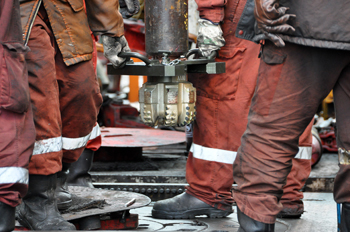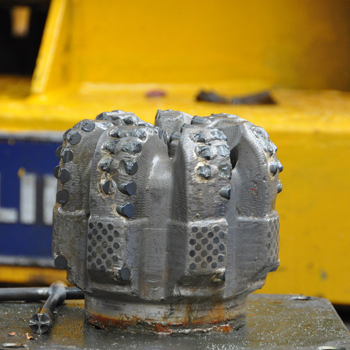

Hard workMay 5, 2012
Last week we made headlines around the world when Chikyu’s drill string reached a new record length for ocean scientific drilling: a total of 7768.5 m measured from the rig floor (7740 m below sea level). OK, maybe “headlines” is stretching it but within the scientific drilling community, this was big news! Credit for this record goes to the hard work and ingenuity of the engineers, drillers and crew of D/V Chikyu. Here in the scientists’ library, we were celebrating their achievement by getting to work on the Logging-While-Drilling data that were collected. This was the first look at the fault we came to study, and the first indication of what kind of rocks we would encounter, and the first test of borehole stability in this deep environment.

New drill bit is assembled to the drill pipe on the rig floor. Photo by Tadashi Yoshizawa.
We poured over the data as it came in ? low resolution in real-time, and after the hole was complete and the instruments were back on board. The logging engineers downloaded the data from the instrument memory ? detailed images of the borehole walls, and long wiggly lines which showed the sediment and rock properties. For me, a field geologist, it was my first time seeing this type of data. I tried to imagine what the rocks would look like in an outcrop, or feel like in my hand, and what small features I could see with my hand lens if I had a sample to examine. There were some clues which the logging scientists helped me learn how to read in the data: fracture patterns, the subtle traces of sedimentary bedding. Most exciting were the points in the data which showed big changes in rock type down the hole: the transition from silica-rich sediments to a layer of clay, for example. I hope soon we will recover some core and I will get to find out if my imagined samples are anything like the real thing.
One of the old assumptions we are testing on this mission is whether the deep water sediments that make up the hanging wall of a subduction thrust fault are very soft and weak (and just get pushed around by earthquake slip in the stronger rocks at deeper depths in the fault) or whether they are strong enough to release some elastic energy themselves. We won’t be able to answer this until we have the sediment samples in hand, sometime in a week or two. But in case you’re wondering, this is what 856m of drilling will do to a new drill bit:

After the drilling, damage to the microdiamond-bearing drill teeth.
This probably happened when drilling through hard chert! Photo by Tadashi Yoshizawa.

















